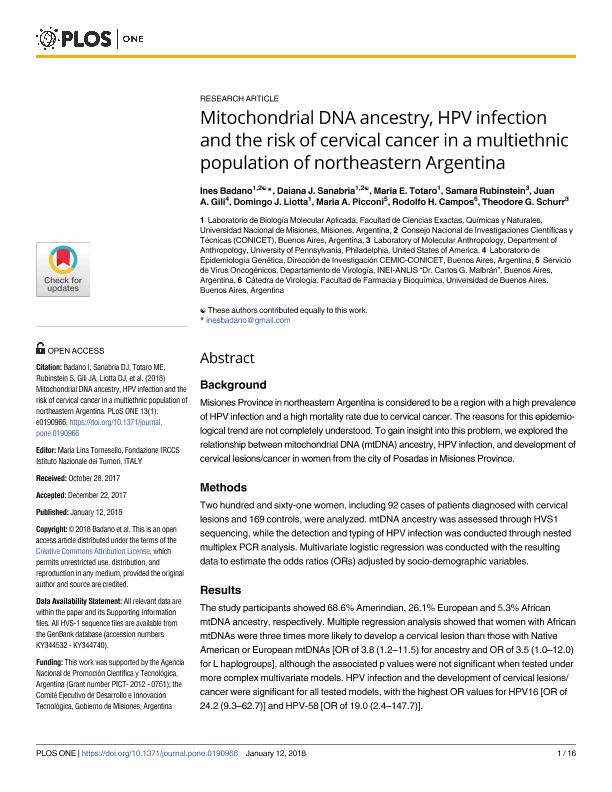Mostrar el registro sencillo del ítem
dc.contributor.author
Badano, Ines

dc.contributor.author
Sanabria, Daiana Jimena

dc.contributor.author
Tótaro, Roxana María

dc.contributor.author
Rubinstein, Samara
dc.contributor.author
Gili, Juan Antonio

dc.contributor.author
Liotta, Domingo Javier

dc.contributor.author
Picconi, Maria A.
dc.contributor.author
Campos, Rodolfo Hector

dc.contributor.author
Schurr, Theodore G.
dc.date.available
2019-10-21T23:00:24Z
dc.date.issued
2018-01
dc.identifier.citation
Badano, Ines; Sanabria, Daiana Jimena; Tótaro, Roxana María; Rubinstein, Samara; Gili, Juan Antonio; et al.; Mitochondrial DNA ancestry, HPV infection and the risk of cervical cancer in a multiethnic population of northeastern Argentina; Public Library of Science; Plos One; 13; 1; 1-2018; 1-16
dc.identifier.issn
1932-6203
dc.identifier.uri
http://hdl.handle.net/11336/86792
dc.description.abstract
Background: Misiones Province in northeastern Argentina is considered to be a region with a high prevalence of HPV infection and a high mortality rate due to cervical cancer. The reasons for this epidemiological trend are not completely understood. To gain insight into this problem, we explored the relationship between mitochondrial DNA (mtDNA) ancestry, HPV infection, and development of cervical lesions/cancer in women from the city of Posadas in Misiones Province.
Methods: Two hundred and sixty-one women, including 92 cases of patients diagnosed with cervical lesions and 169 controls, were analyzed. mtDNA ancestry was assessed through HVS1 sequencing, while the detection and typing of HPV infection was conducted through nested multiplex PCR analysis. Multivariate logistic regression was conducted with the resulting data to estimate the odds ratios (ORs) adjusted by socio-demographic variables.
Results: The study participants showed 68.6% Amerindian, 26.1% European and 5.3% African mtDNA ancestry, respectively. Multiple regression analysis showed that women with African mtDNAs were three times more likely to develop a cervical lesion than those with Native American or European mtDNAs [OR of 3.8 (1.2–11.5) for ancestry and OR of 3.5 (1.0–12.0) for L haplogroups], although the associated p values were not significant when tested under more complex multivariate models. HPV infection and the development of cervical lesions/cancer were significant for all tested models, with the highest OR values for HPV16 [OR of 24.2 (9.3–62.7)] and HPV-58 [OR of 19.0 (2.4–147.7)].
Conclusion: HPV infection remains a central risk factor for cervical cancer in the Posadas population. The potential role of African mtDNA ancestry opens a new avenue for future medical association studies in multiethnic populations, and will require further confirmation in large-scale studies.
dc.format
application/pdf
dc.language.iso
eng
dc.publisher
Public Library of Science

dc.rights
info:eu-repo/semantics/openAccess
dc.rights.uri
https://creativecommons.org/licenses/by/2.5/ar/
dc.subject
HPV INFECTION
dc.subject
MITOCHONDRIAL DNA ANCESTRY
dc.subject
CERVICAL CANCER
dc.subject
POSADAS MISIONES ARGENTINA
dc.subject.classification
Otras Medicina Básica

dc.subject.classification
Medicina Básica

dc.subject.classification
CIENCIAS MÉDICAS Y DE LA SALUD

dc.title
Mitochondrial DNA ancestry, HPV infection and the risk of cervical cancer in a multiethnic population of northeastern Argentina
dc.type
info:eu-repo/semantics/article
dc.type
info:ar-repo/semantics/artículo
dc.type
info:eu-repo/semantics/publishedVersion
dc.date.updated
2019-09-27T14:56:36Z
dc.journal.volume
13
dc.journal.number
1
dc.journal.pagination
1-16
dc.journal.pais
Estados Unidos

dc.journal.ciudad
San Francisco
dc.description.fil
Fil: Badano, Ines. Consejo Nacional de Investigaciones Científicas y Técnicas. Centro Científico Tecnológico Conicet - Nordeste; Argentina. Universidad Nacional de Misiones. Facultad de Ciencias Exactas, Químicas y Naturales. Laboratorio de Biología Molecular Aplicada; Argentina
dc.description.fil
Fil: Sanabria, Daiana Jimena. Consejo Nacional de Investigaciones Científicas y Técnicas. Centro Científico Tecnológico Conicet - Nordeste; Argentina. Universidad Nacional de Misiones. Facultad de Ciencias Exactas, Químicas y Naturales. Laboratorio de Biología Molecular Aplicada; Argentina
dc.description.fil
Fil: Tótaro, Roxana María. Universidad Nacional de Misiones. Facultad de Ciencias Exactas, Químicas y Naturales. Laboratorio de Biología Molecular Aplicada; Argentina
dc.description.fil
Fil: Rubinstein, Samara. University of Pennsylvania; Estados Unidos
dc.description.fil
Fil: Gili, Juan Antonio. Consejo Nacional de Investigaciones Científicas y Técnicas. Oficina de Coordinación Administrativa Parque Centenario. CEMIC-CONICET. Centro de Educaciones Médicas e Investigaciones Clínicas "Norberto Quirno". CEMIC-CONICET.; Argentina
dc.description.fil
Fil: Liotta, Domingo Javier. Consejo Nacional de Investigaciones Científicas y Técnicas. Centro Científico Tecnológico Conicet - Nordeste; Argentina. Universidad Nacional de Misiones. Facultad de Ciencias Exactas, Químicas y Naturales. Laboratorio de Biología Molecular Aplicada; Argentina
dc.description.fil
Fil: Picconi, Maria A.. Dirección Nacional de Instituto de Investigación. Administración Nacional de Laboratorio e Instituto de Salud “Dr. C. G. Malbrán”; Argentina
dc.description.fil
Fil: Campos, Rodolfo Hector. Consejo Nacional de Investigaciones Científicas y Técnicas. Oficina de Coordinación Administrativa Houssay; Argentina. Universidad de Buenos Aires. Facultad de Farmacia y Bioquímica. Departamento de Microbiología, Inmunología y Biotecnología; Argentina
dc.description.fil
Fil: Schurr, Theodore G.. University of Pennsylvania; Estados Unidos
dc.journal.title
Plos One

dc.relation.alternativeid
info:eu-repo/semantics/altIdentifier/url/http://journals.plos.org/plosone/article?id=10.1371/journal.pone.0190966
dc.relation.alternativeid
info:eu-repo/semantics/altIdentifier/doi/https://doi.org/10.1371/journal.pone.0190966
Archivos asociados
